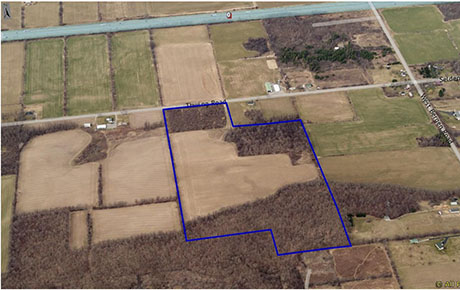
Concerned about setting a bad precedent, the Genesee County Planning Board on Thursday rejected a proposed public utility use variance for a solar project on farmland at 7120 Thwing Road, Le Roy.
County Planning Director Felipe Oltramari told Ty Baccile, project manager, solar development for Washington, D.C.-based CleanChoice Energy, that the company was going in the wrong direction requesting a public utility use variance.
"I think you skipped a step in not getting an interpretation from the (Le Roy) Zoning Board of Appeals," Oltramari said. "It falls under their jurisdiction to provide a definition for a public utility. If they determine you fall within that definition, then just apply for a special use permit."
CleanChoice Energy began working with Gary W. Clark and his family of farmers in 2019 on siting the project but since developing the initial proposal, the Town of Le Roy has passed new solar farm regulations. The regulations' new code means a project such as this must fall within the definition of a public utility.
Based on prior case law and state codes, Oltramari said the county planning board can't make that determination without setting a precedent that would affect solar project zoning codes in other towns.
However, if the Le Roy ZBA determined the project fit the public utility definition, then the decision remains confined to how Le Roy interprets its own codes.
The Clark family, three generations of farmers with more than 575 acres of cropland in Le Roy and Stafford, settled on a solar project as a way to supplement and diversify their company's revenue stream. The proposed project represents 5 percent of the farm acreage and is considered less suitable farmland.
CleanChoice Energy is proposing a 4.95-megawatt solar project on the property.
The project, under state law, is defined as a "Community Solar Project." Solar power from such projects is only distributed locally and cannot be carried to other regions via transmission lines.
There is a limited hosting capacity for these types of solar projects.
Substations and three-phase distribution feeds can only support a small number of these projects and facilities must be sited close to substations.
The projects are also limited by a shortage of land suitable for hosting them. Environmental, regulatory, and permitting constraints at potential host sites eliminate many properties from consideration. Prime farmland, wetlands, land hosting threatened and endangered species, and acreage that's just too expensive are not viable options.
Among the selected parcel's advantages are: that it is relatively flat; will connect to existing National Grid power lines; will not interfere with farm operations; few trees will need to be removed; and existing trees and bushes create a visual barrier; it sits at the top of a hill --making it less visible to surrounding residents (nobody is looking down on it).
Motorists on Thwing Road won't be able to see the solar project as they drive by, said project manager Baccile.
Electricity generated by the project would be transferred to National Grid for distribution daily to customers enrolled in the CleanChoice's Community Solar Program. The project would generate enough energy to power 800 to 850 homes in the Town of Le Roy and surrounding towns.
According to a document from CleanChoice, "Based on National Grid Standard Service electric supply rate and a customer average monthly use, the project is expected to create an energy supply saving of approximately $60,000 annually. Energy bills are a combination of supply prices, which are based largely on market conditions, and delivery prices, which are set by regulation. Customers choosing to subscribe to the project benefit by the monthly savings regardless of usage, weather, or market price fluctuations."
Town of Le Roy residents would get the first shot at subscribing to the program.
Photo: Aerial photo from the project proposal application.
